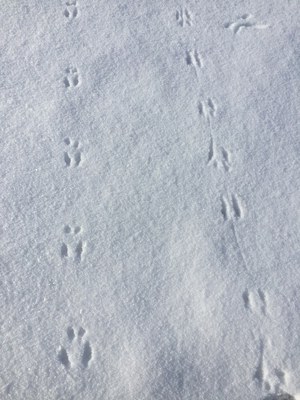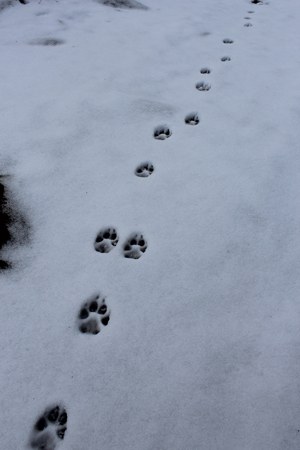If you are like many central Oregonians this winter, you are spending a lot of time outside in the snow. Whether you are skiing, sledding or snowshoeing, taking the time to pause and observe wildlife tracks in the winter can be a great way to learn a little more about the wildlife with whom we share these snowy playgrounds.
Where to start? First, think about your timing. Fresh snow is ideal, but soft snow can also prove fruitful! Then, get yourself a bit down the trail and out of busy areas. This will help provide a clean slate with fewer tracks from pets or people. Next, find your track or footprint in the snow. You may think you want to start by examining the track itself, but instead you first want to focus on the pattern of the track.
Walkers leave patterns of a straight line of single prints that alternate sides or a line of prints that are almost exactly on top of each other. This is an animal that places their hind foot almost exactly in the print left by their front foot. These kinds of tracks tend to be left by coyote, fox, bobcat, deer, or elk.
Hoppers leave a trail of two small prints and two large prints. These animals touch the ground with both front feet and then bring their back feet around to place them in front of their forefeet. These kinds of tracks tend to come from a squirrel, mouse, or rabbit.
Waddlers tend to walk in a wider zig zag or in a more random looking pattern. They tend to be left by--you guessed it--animals that are more squat and waddle like a porcupine, raccoon or beaver. Bounders leave regularly spaced pairs or groups of prints and tend to be left by animals in the weasel family: otter, mink, marten, fisher, and weasel. Finally, take a look at the size of your pattern. How far apart are the individual prints widthwise? How long is the animal's stride--the distance between the groups of tracks? Exact measurements can help with identification, but even estimations can help you narrow the field as you work to discover your animal.
Finally, once you’ve examined your pattern and print, you can start to narrow the field. Get a wildlife tracking book (Wildlife of the Pacific Northwest, by David Moskowitz) or try the free version of the iTrack Wildlife app. Both have helpful tools like rulers to measure your tracks and patterns and they walk you through the pattern and print options that lead to different animals. If you are pressed for time, take photos of the pattern and print so you can look it up later.
Parting words: patience! You may not identify your tracks every time, but half the fun is trying to piece together the story of what animal was there and what they were doing on a snowy winter day in the forest.
This story first appeared in the Source Weekly.
Learn more about the nature of Central Oregon:
